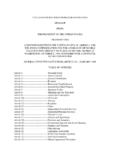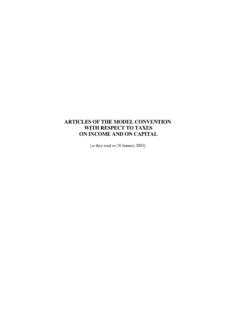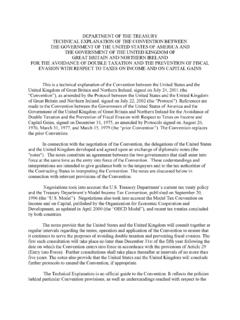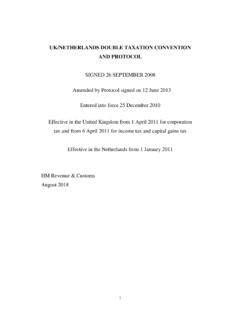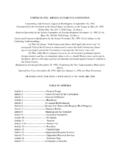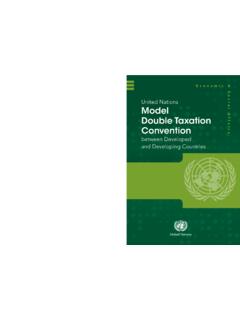Transcription of COMMENTARIES ON THE ARTICLES OF THE MODEL TAX …
1 COMMENTARIES ON THE ARTICLES OF THE MODEL TAX CONVENTION45 MODEL TAX convention (CONDENSED VERSION) ISBN 978-92-64-08948-8 OECD 2010 commentary ON ARTICLE 1 CONCERNING THE PERSONS COVERED BY THE the earliest conventions in general were applicable to citizens of theContracting States, more recent conventions usually apply to residents of one or bothof the Contracting States irrespective of nationality. Some conventions are of evenwider scope because they apply more generally to taxpayers of the ContractingStates; they are, therefore, also applicable to persons, who, although not residing ineither State, are nevertheless liable to tax on part of their income or capital in each ofthem. It has been deemed preferable for practical reasons to provide that theConvention is to apply to persons who are residents of one or both of the ContractingStates. The term resident is defined in Article of the convention to laws differ in the treatment of partnerships.
2 These differences createvarious difficulties when applying tax Conventions in relation to partnerships. Thesedifficulties are analysed in the report by the Committee on Fiscal Affairs entitled TheApplication of the OECD MODEL Tax convention to Partnerships ,1 the conclusions ofwhich have been incorporated below and in the commentary on various otherprovisions of the MODEL Tax discussed in that report, a main source of difficulties is the fact that somecountries treat partnerships as taxable units (sometimes even as companies) whereasother countries adopt what may be referred to as the fiscally transparent approach,under which the partnership is ignored for tax purposes and the individual partnersare taxed on their respective share of the partnership s first difficulty is the extent to which a partnership is entitled as such to thebenefits of the provisions of the convention . Under Article 1, only persons who areresidents of the Contracting States are entitled to the benefits of the tax Conventionentered into by these States.
3 While paragraph 2 of the commentary on Article 3explains why a partnership constitutes a person, a partnership does not necessarilyqualify as a resident of a Contracting State under Article a partnership is treated as a company or taxed in the same way, it is aresident of the Contracting State that taxes the partnership on the grounds mentionedin paragraph 1 of Article 4 and, therefore, it is entitled to the benefits of theConvention. Where, however, a partnership is treated as fiscally transparent in a State,the partnership is not liable to tax in that State within the meaning of paragraph 1 ofArticle 4, and so cannot be a resident thereof for purposes of the convention . In such acase, the application of the convention to the partnership as such would be refused,unless a special rule covering partnerships were provided for in the convention . Wherethe application of the convention is so refused, the partners should be entitled, with1 Reproduced in Volume II of the full-length version of the OECD MODEL Tax convention atpage R(15) ON ARTICLE 146 MODEL TAX convention (CONDENSED VERSION) ISBN 978-92-64-08948-8 OECD 2010respect to their share of the income of the partnership, to the benefits provided by theConventions entered into by the States of which they are residents to the extent thatthe partnership s income is allocated to them for the purposes of taxation in their Stateof residence (see paragraph of the commentary on Article 4).
4 Relationship between the partnership s entitlement to the benefits of a taxConvention and that of the partners raises other issue is the effect that the application of the provisions of the convention toa partnership can have on the taxation of the partners. Where a partnership is treatedas a resident of a Contracting State, the provisions of the convention that restrict theother Contracting State s right to tax the partnership on its income do not apply torestrict that other State s right to tax the partners who are its own residents on theirshare of the income of the partnership. Some states may wish to include in theirconventions a provision that expressly confirms a Contracting State s right to taxresident partners on their share of the income of a partnership that is treated as aresident of the other issue is that of the effect of the provisions of the convention on aContracting State s right to tax income arising on its territory where the entitlement tothe benefits of one, or more than one, Conventions is different for the partners and thepartnership.
5 Where, for instance, the State of source treats a domestic partnership asfiscally transparent and therefore taxes the partners on their share of the income ofthe partnership, a partner that is resident of a State that taxes partnerships ascompanies would not be able to claim the benefits of the convention between the twoStates with respect to the share of the partnership s income that the State of sourcetaxes in his hands since that income, though allocated to the person claiming thebenefits of the convention under the laws of the State of source, is not similarlyallocated for purposes of determining the liability to tax on that item of income in theState of residence of that results described in the preceding paragraph should obtain even if, as amatter of the domestic law of the State of source, the partnership would not beregarded as transparent for tax purposes but as a separate taxable entity to which theincome would be attributed, provided that the partnership is not actually consideredas a resident of the State of source.
6 This conclusion is founded upon the principle thatthe State of source should take into account, as part of the factual context in which theConvention is to be applied, the way in which an item of income, arising in itsjurisdiction, is treated in the jurisdiction of the person claiming the benefits of theConvention as a resident. For States which could not agree with this interpretation ofthe Article, it would be possible to provide for this result in a special provision whichwould avoid the resulting potential double taxation where the income of thepartnership is differently allocated by the two , as described in paragraph , income has flowed through a transparentpartnership to the partners who are liable to tax on that income in the State of theirresidence then the income is appropriately viewed as paid to the partners since it isCOMMENTARY ON ARTICLE 147 MODEL TAX convention (CONDENSED VERSION) ISBN 978-92-64-08948-8 OECD 2010to them and not to the partnership that the income is allocated for purposes ofdetermining their tax liability in their State of residence.
7 Hence the partners, in thesecircumstances, satisfy the condition, imposed in several ARTICLES , that the incomeconcerned is paid to a resident of the other Contracting State . Similarly therequirement, imposed by some other ARTICLES , that income or gains are derived by aresident of the other Contracting State is met in the circumstances described interpretation avoids denying the benefits of tax Conventions to a partnership sincome on the basis that neither the partnership, because it is not a resident, nor thepartners, because the income is not directly paid to them or derived by them, can claimthe benefits of the convention with respect to that income. Following from theprinciple discussed in paragraph , the conditions that the income be paid to, orderived by, a resident should be considered to be satisfied even where, as a matter ofthe domestic law of the State of source, the partnership would not be regarded astransparent for tax purposes, provided that the partnership is not actually consideredas a resident of the State of cases involving three States pose difficult problems with respect tothe determination of entitlement to benefits under Conventions.
8 However, manyproblems may be solved through the application of the principles described inparagraphs to Where a partner is a resident of one State, the partnership isestablished in another State and the partner shares in partnership income arising in athird State then the partner may claim the benefits of the convention between hisState of residence and the State of source of the income to the extent that thepartnership s income is allocated to him for the purposes of taxation in his State ofresidence. If, in addition, the partnership is taxed as a resident of the State in which itis established then the partnership may itself claim the benefits of the Conventionbetween the State in which it is established and the State of source. In such a case of double benefits , the State of source may not impose taxation which is inconsistentwith the terms of either applicable convention ; therefore, where different rates areprovided for in the two Conventions, the lower will be applied.
9 However, ContractingStates may wish to consider special provisions to deal with the administration ofbenefits under Conventions in situations such as these, so that the partnership mayclaim benefits but partners could not present concurrent claims. Such provisions couldensure appropriate and simplified administration of the giving of benefits. No benefitswill be available under the convention between the State in which the partnership isestablished and the State of source if the partnership is regarded as transparent for taxpurposes by the State in which it is established. Similarly no benefits will be availableunder the convention between the State of residence of the partner and the State ofsource if the income of the partnership is not allocated to the partner under thetaxation law of the State of residence. If the partnership is regarded as transparent fortax purposes by the State in which it is established and the income of the partnershipis not allocated to the partner under the taxation law of the State of residence of thepartner, the State of source may tax partnership income allocable to the partnerwithout ON ARTICLE 148 MODEL TAX convention (CONDENSED VERSION) ISBN 978-92-64-08948-8 OECD in how countries apply the fiscally transparent approach may createother difficulties for the application of tax Conventions.
10 Where a State considers that apartnership does not qualify as a resident of a Contracting State because it is not liableto tax and the partners are liable to tax in their State of residence on their share of thepartnership s income, it is expected that that State will apply the provisions of theConvention as if the partners had earned the income directly so that the classificationof the income for purposes of the allocative rules of ARTICLES 6 to 21 will not be modifiedby the fact that the income flows through the partnership. Difficulties may arise,however, in the application of provisions which refer to the activities of the taxpayer,the nature of the taxpayer, the relationship between the taxpayer and another party toa transaction. Some of these difficulties are discussed in paragraphs of theCommentary on Article 5 and paragraphs and of the commentary on Article , a number of other difficulties arise where different rules of theConvention are applied by the Contracting States to income derived by a partnership orits partners, depending on the domestic laws of these States or their interpretation ofthe provisions of the convention or of the relevant facts.










